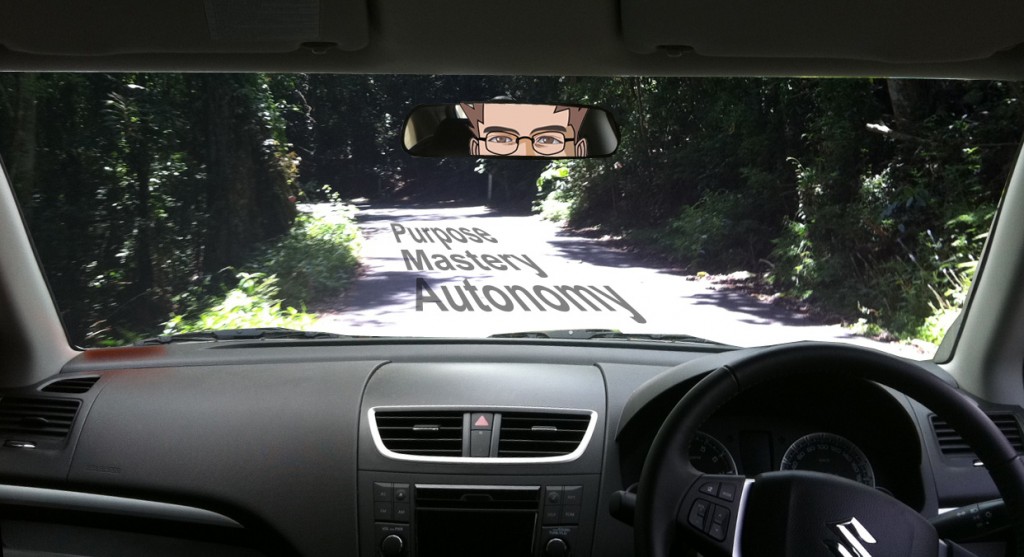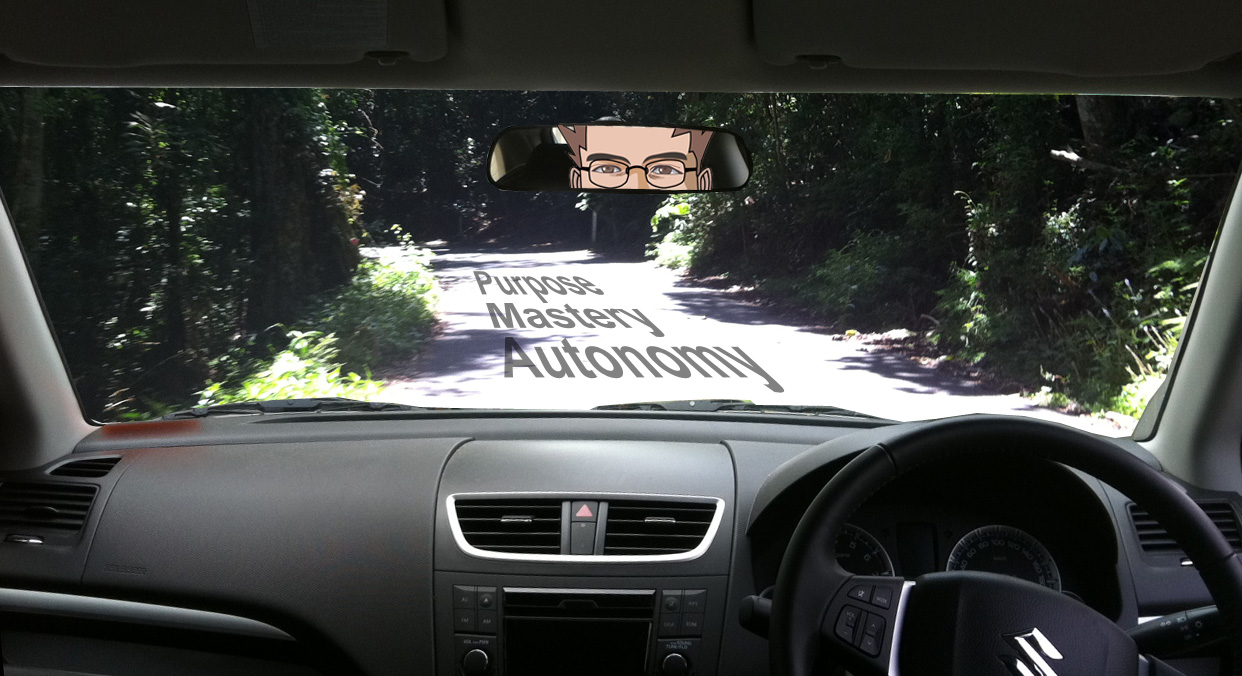A Drive with Daniel Pink through autonomy, mastery and purpose: Why do we continue to get motivations so wrong?
There appears to be a gap between what science knows and what business does. Intrinsic motivation produces higher long-term profits, but organisations continue to implement soul-destroying carrot and stick practices. And yet will it take a carrot or stick to motivate business leaders to change?

Drive through the bullet points
Drive by Daniel Pink is like a 200-page social science university assignment, only readable. Pink borrows outcomes from research articles and contemporary management books to present a concise case on motivation. Drive plots a path through findings from dozens of authors including Harlow in 1940, McGreggor in 1960, Deci in 1969, Friedman and Rosenman in 1974 and more recently Seligman and Csikszentmihalyi.
Despite the research, modern organisations continue to operate under what Pink calls “Motivation 2.0”, a system that has evolved beyond simple self-preservation and into a model of carrots and sticks. A challenge with this approach is that it is not suited for how we organise, think and perform tasks in the increasing complexity of today’s business. Instead of routine algorithmic (linear) processes, workers today are presented with heuristic challenges requiring experimentation and lateral thinking.
Research demonstrates that an extrinsic reward and punishment is not appropriate for these uncertain environments. If we continue to offer carrots and sticks with an end goal of increased profit, we get:
Less of what we want…
- They can extinguish intrinsic motivation
- They can diminish performance
- They can crush creativity
- They can crowd out good behaviour
…and more of what we don’t want
- They can encourage cheating, shortcuts, and unethical behaviour
- They can become addictive
- They can foster short-term thinking
Pink refers to those operating under the current model as the undesirable “Type X” approach which is fuelled by extrinsic desires. This is in comparison to the internally motivated Type I approach. These two types are differentiated as:
- Type I behaviour is made, not born
Type X can become Type I. - Type I almost always outperforms Type X in the long run
Extrinsic rewards can produce fast results but is difficult to sustain and does not assist in mastery. - Type I behaviour does not disdain money or recognition
Compensation must at least hit a baseline, after which it takes the issue of money off the table to focus on the work itself. For Type X’s, money is the table. - Type I behaviour is a renewable resource
Think of Type X as coal and Type I as the sun. - Type I behaviour promotes greater physical and mental well being
Proven to result in higher self-esteem, better interpersonal relationships, greater general well-being.
So how do we become motivated? Pink outlines three critical pieces:
- Autonomy
Controlling management approaches assume people are passive and inert and require prodding. Autonomy approaches assume people are active, looking for interesting work and curious and self-engaging. Autonomous motivation has proven to promote greater conceptual understanding, result in better grades, enhance persistence at school and in sporting activities, generate higher productivity, less burnout, and greater levels of psychological well-being. - Mastery
Mastery is the desire to get better at something that matters. First, mastery is a mindset, in that we either believe we can get better or we don’t. Second, mastery is a pain, in that it involves not only working harder but working longer at the same thing. Finally, mastery is an asymptote, or a straight line that you may come close to but never reach. - Purpose
Purpose provides a context for autonomy and mastery. Addresses the situation that even when we get what we want, it is not what we need.
A drive to be different to do different
As I read Drive, I felt frustrations similar to those expressed in my post on Firms of Endearment. I read the research that is clearly not accepted by the commercial environments in which we operate. As Pink states, “profit-driven approaches relegate purpose to a nice accessory if you want it, so long as it does not get in the way of the important stuff”.
In the commercial world, asking why we do what we do can result in answers of “because it is cool technology”, “because we will get more money”, or “to support the business objectives”. These outcomes are then achieved by carrots and sticks that are proportionate in magnitude to the risk of the endeavour. Questions about meaning beyond these points can be met with silence, sneers, or puzzled looks.
And yet the research shows this should not be the case. Success stories abound that provide autonomy through outcome rather than output based approaches, mastery through focusing on individual strengths and custom role definition, and purpose through engagement with tasks relevant to the individual.
As I continue to find in studies and management experience: to do different, we must be different, and changing convention requires the leaders to reflect on who they are. The question to business leaders is whether we are going to do changes to improve autonomy, mastery and purpose; or will we be the type of leader who makes the changes.
What is the path to change the situation? Will the free hand of the market act as a carrot and stick to reward organisations who “get it”? At what point does the commercial machine as a whole begin to actively talk about principles such as intrinsic motivation and meaning behind our actions?
Bottom line:
- The current model of carrots and sticks is not appropriate for our environment; and
- Intentionally introducing autonomy, mastery and purpose into our organisations will provide better results.
As leaders and change agents, we have a small window of opportunity to have people talk about the type of leader we are rather than the things that we do. To be such a leader should in itself be the purpose behind our intrinsic motivation. If it is, then research proves nothing can stop us.


A well thought out post Chad. I look forward to more posts that take the subject deeper.
Well started Chad! Further, the question to business leaders is whether they are capable of really comprehending the changes required to improve autonomy, mastery and purpose. And committed to follow through rather than a non-sustainable “splatter gun” approach.
I think the comment regarding heuristic challenges is a very important one in a broader sense than just motivation. As children we are conditioned to think in a linear fashion (we are taught through textbooks and what others know) – e.g. how we learn ABC and how we learn maths 1+1=2 etc.
Teaching through experience and other non traditional techniques would yield much better outcomes in my view and studies have already shown this time and time again. Whilst traditional methods do work (to current social expectations), I think they also stiffle creativity and reduce the potential of individuals plus create a fair amount of stress for individuals.
It is no surprise that some of the best and brightest people in history never finished school in the traditional sense and gained much of their knowledge through experiences.
looking forward to more posts from you on Dan Pink material
Good thoughts, Barry.
Reinforces the concept of the “learning organisation”, a necessity in our changing technology worlds. Likewise, I would be interested in more perspectives about intentional non-traditional learning in workplace settings.
My feeling, from an organization perspective, and having new people come in is that you first do purpose (and harmonize with person on that) and then there is mastery of what is needed in the organization context. After these two are handled, a person has autonomy in the context of the other two. A person who is low on skills needs help, and more structure.